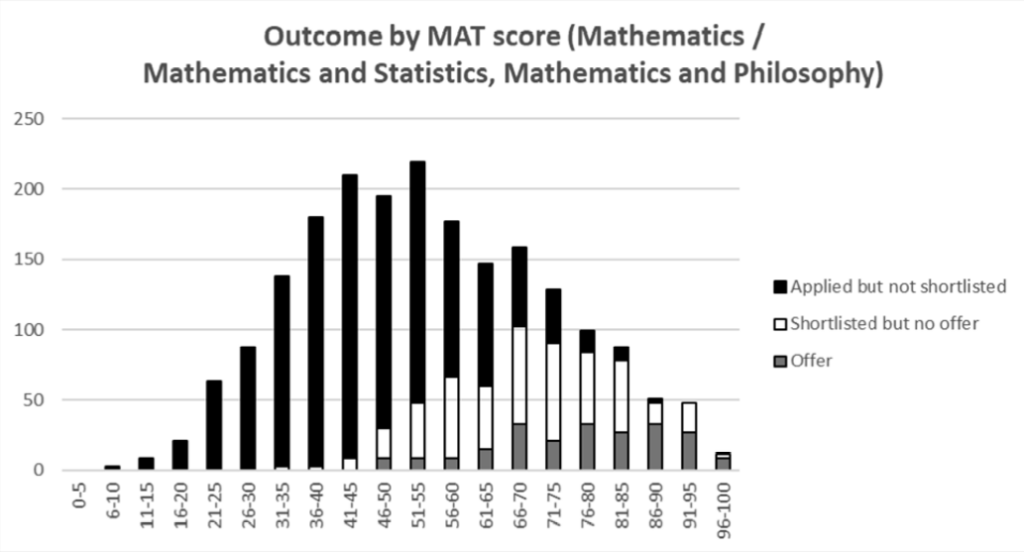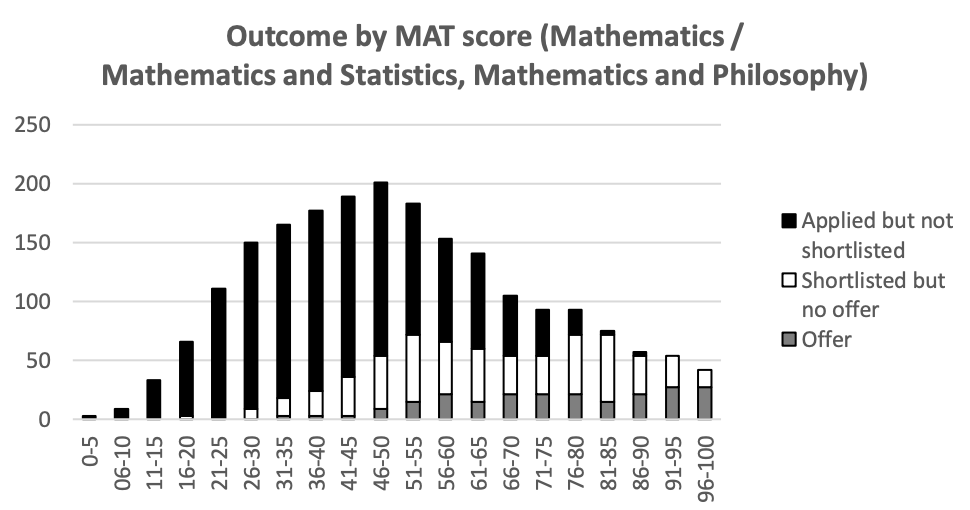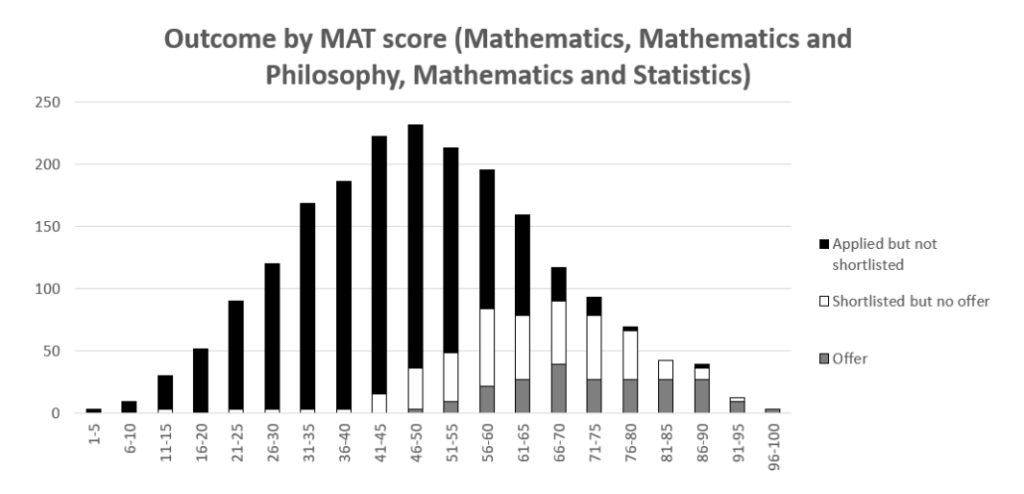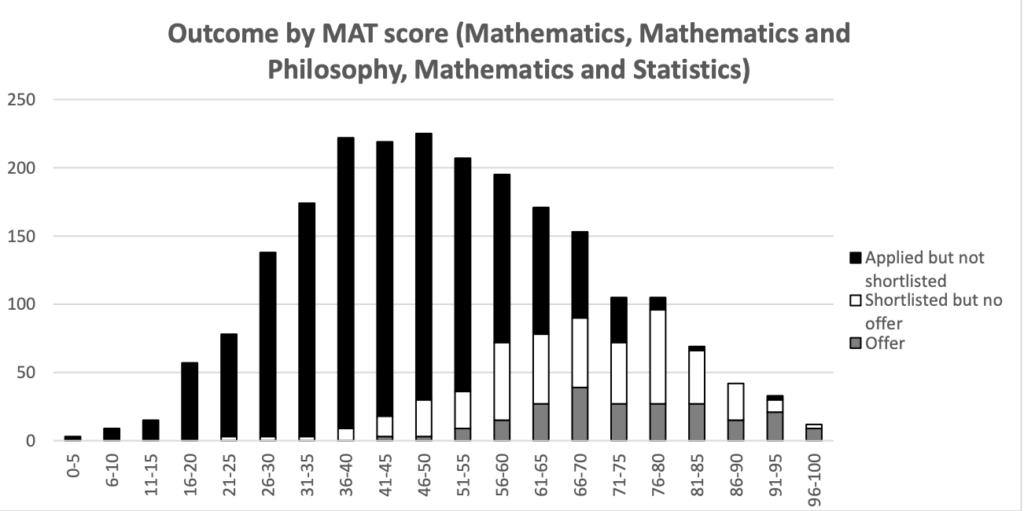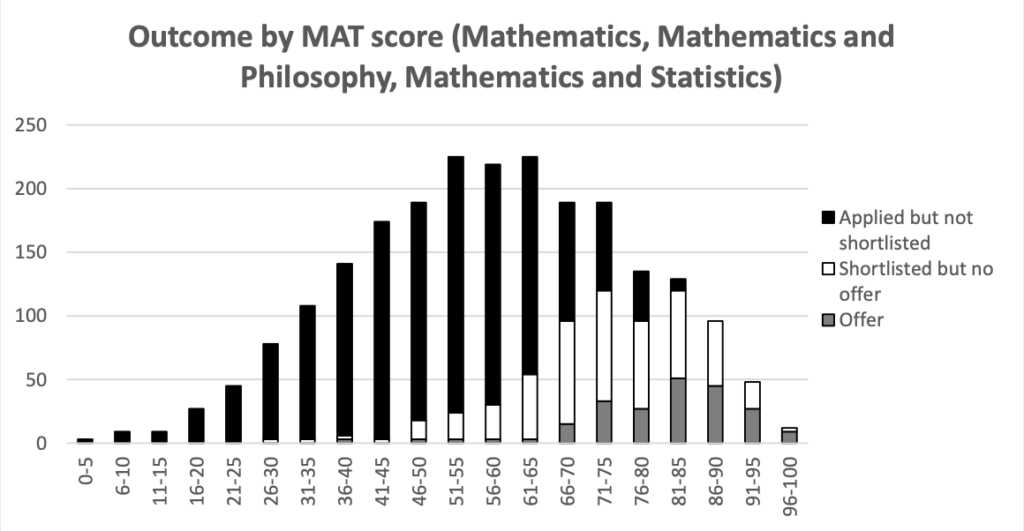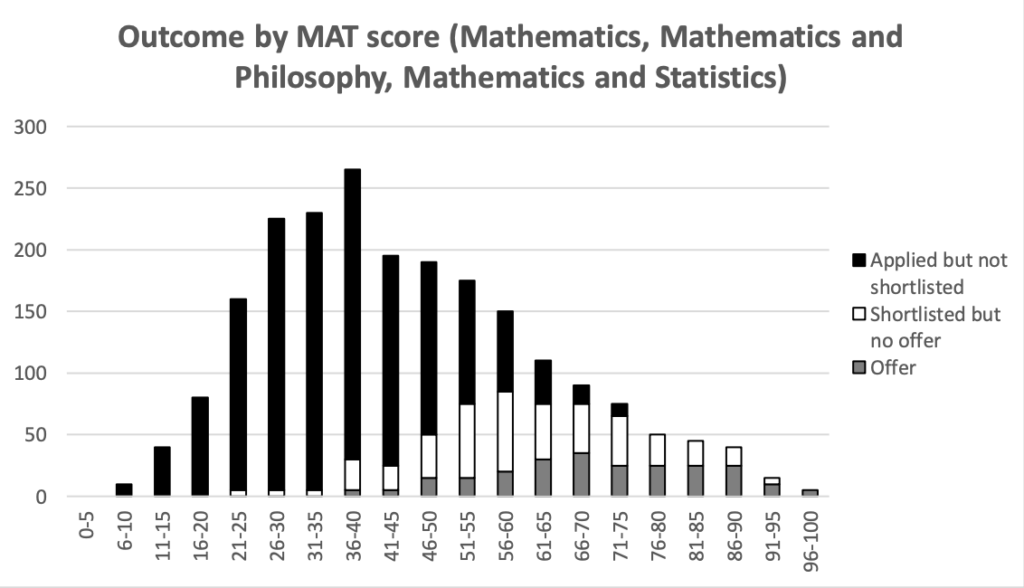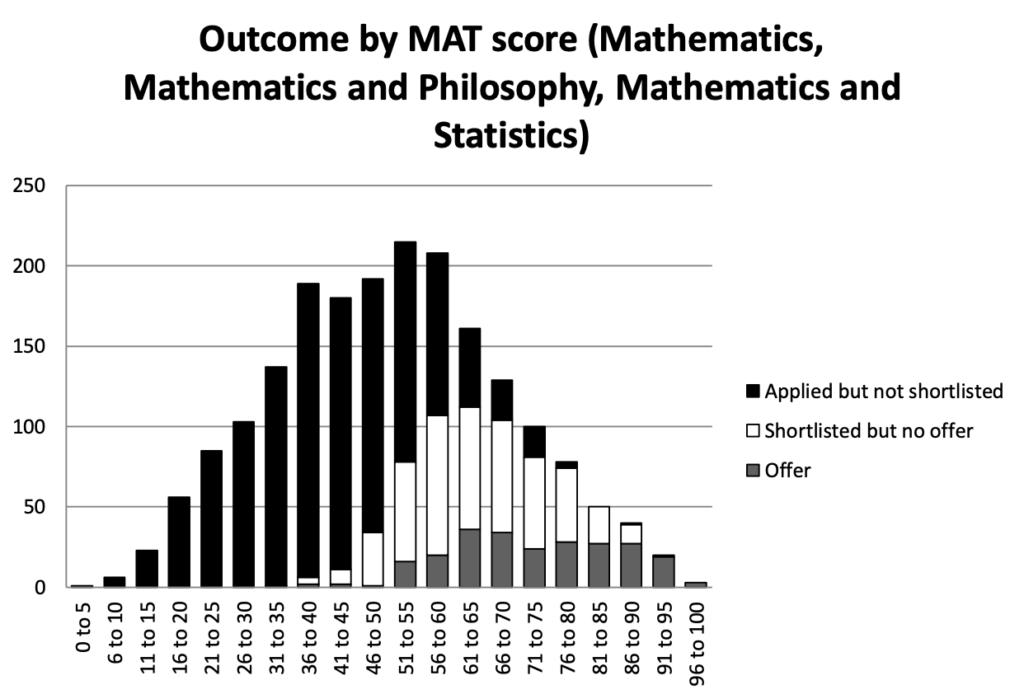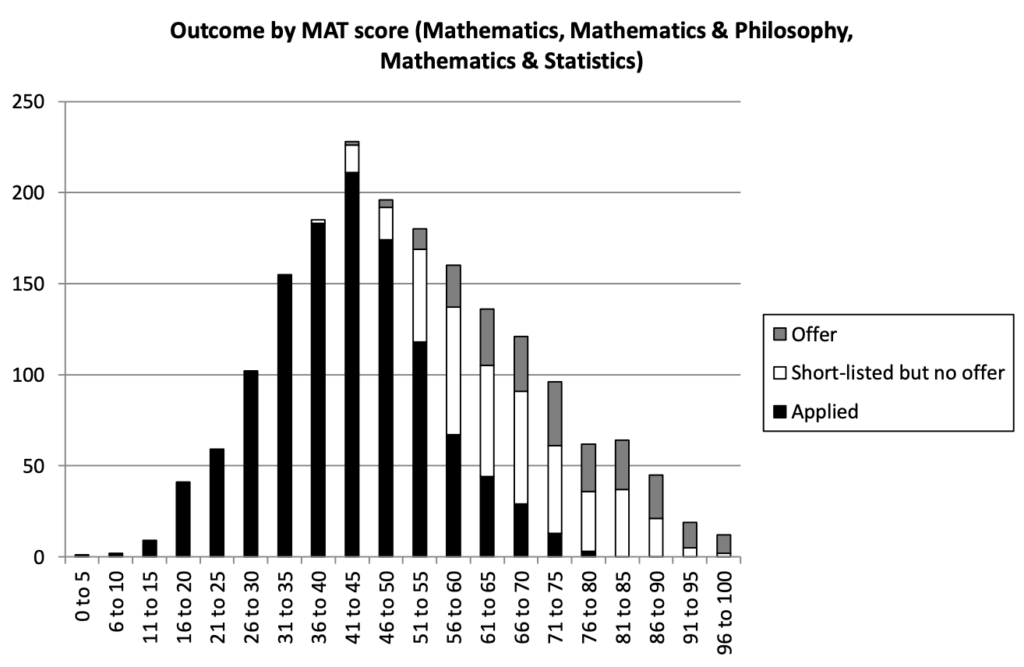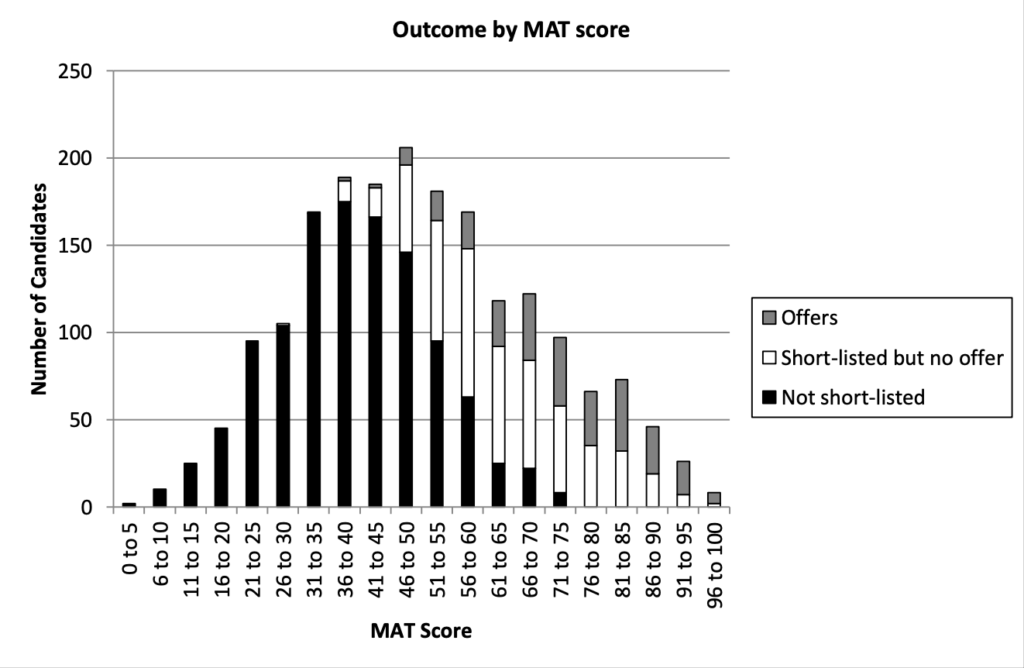MAT Guides
Oxford MAT Scores 2024 - The Definitive Guide to your MAT Results
Written by: Matt Amalfitano-Stroud
When taking any admissions test, it’s important to know exactly how it’s scored so you can know what you need to do to get as many marks as possible. Compared to many other tests, the scoring of the MAT is quite complicated, so this guide will show you exactly where your points come from, what you should be aiming to get and how previous applicants have managed in past admissions cycles. Let’s get started!
1/4
HOW IS THE MAT SCORED?
The first thing we need to understand is how you’ll be gaining marks within the MAT, so let’s break it down!


Unlike many admissions tests currently used by universities in the UK, the Maths Admissions Test (MAT) is not a strictly multiple-choice test, which automatically makes the scoring system a bit more complex. The whole exam is worth 100 marks, which are earned over the course of seven questions (only 5 of which are answered by each applicant). Between these seven questions, there are two different question formats:
Question 1 - 25
Multiple-Choice Questions
Questions 26 -27
Written Questions with 3 -4 Parts
Of course, these two questions types will have different scoring systems, so let’s take a look:
Question 1
Being a multiple-choice section, the marking scheme for this question is definitely simpler. All together, these are worth 70 marks, with each part of this question worth between 2 and 4 marks. According to the MAT practice test released by Oxford, this will be how it is broken down:
- Questions 1 – 10: 2 Marks each
- Questions 11 – 20: 3 Marks Each
- Questions 21 -25: 4 Marks Each
Marks are only awarded for the selection of the correct answer in these questions. The test is digital, so you will not be marked for any working out you do on paper. There is also no negative marking here, so you will not lose marks for getting an answer incorrect.
Exams.Ninja Tip
If you struggle to figure out one of these questions, you shouldn’t spend too long trying to get it. Time is limited and many of the later questions are much more time-consuming, so make a note to come back to it later on. If time starts running out, you may not be able to properly try and work it out, so just select the most likely option. There’s nothing to lose from doing this and you’ll have a 1/5 chance of getting it correct!
Questions 25 - 26
The final two questions are where things get a bit more complicated. These are all written questions with multiple parts that are each marked separately. However, these questions are both worth 15 marks each, so this portion of the test will be worth 30 marks in total.
As we’ve already covered, each of these questions is made up of 3 – 4 parts. Each part is worth anywhere between 2 – 5 marks, with the MAT practice test featuring these marks:
Q26 Part 1: 4 Marks
Q26 Part 2: 6 Marks
Q26 Part 3: 5 Marks
Q27 Part 1: 2 Marks
Q27 Part 2: 3 Marks
Q27 Part 3: 6 Marks
Q27 Part 4: 4 Marks
Questions that reward the most marks are those which require lots of working out, which you are going to have to demonstrate clearly and accurately in order to gain said marks. Even the smaller questions may require this though, so it’s safest to outline every process you take when answering these questions.
You can learn more about the content of these questions in our Definitive MAT Starter Guide.
How Do I Get Full Marks in MAT Questions?
First things first, getting full marks on the MAT is extremely difficult and something that very few, if any, applicants achieve each year (which you will see in the previous year’s results). The MAT isn’t about getting a perfect score, it’s more so about doing the best you can do under strict limitations in time and resources. Going into the MAT with the hope of getting 100 marks will likely set you up for disappointment, and it’s really not necessary to get you a good chance of success in your application.
However, it is still handy to know what you should do to get full marks, as it’s not as complicated as you may think once you understand how the test is scored:
Question 1 - 25
This is super simple; just get the question right. You’re working out does not count for any marks in this question, so just make sure you have selected the correct option. Your answer should be marked on the answer grid at the start of your question paper, although Oxford has stated they will still give you the marks if you have forgotten to put your answer here, as long as your selection is made clear on the question paper. This is more of a contingency if you do forget though, so it’s easier just to remember to write in the correct place.
Questions 26 - 27
As we’ve already stated, the different parts of each question are worth between 2 – 6 marks, which you won’t know when answering. However, it all comes down to working out. As long as your working out is clear, thorough and correct, you should be awarded full marks for the part.
You may be wondering if the examiners have a certain standard for how the working out should be. The answer to this is no. Oxford has stated that your working out can follow any method as long as it’s been clearly laid out and leads you to the correct answer.
MAT Score Conversions
Although the process of marking is somewhat complex, the process of converting your score is much simpler; your score isn’t converted! Yes, your final score is simply presented as your total number of marks out of 100. This may sometimes be presented as a percentage, but overall it’s still the same value.
When Do MAT Results Come Out?
Oxford Applicants
After sitting the MAT, your results are received by the University of Oxford straight away. This is done automatically so they will have access to your results before you know what you scored. The shortlisting process takes place throughout November, so you should receive an interview invite by the beginning of December. Your MAT results won’t be made available to you until January, around the same time that Oxford makes its final decisions. By this point, these results won’t serve much use to you but it can still be nice to know how you did, especially if you got an offer.
Other Applicants
Other universities do not require an MAT score for your application to be considered, so you will have the option to decide if you wish to share your results with them or not.
These MAT unis will either be sent your results directly but will not have access to them until you have provided permission or will need to be sent your results manually. This can usually be done by March.
Make sure you get the a great MAT score with Exams.Ninja!
With the MAT.Ninja Preparation Platform, you’ll have access to everything you need to boost your score before the exam. Start for free by signing up today.
2/4
WHAT IS A GOOD MAT SCORE?
Now that we know how the test is marked, let’s see what you should be aiming for in order to improve your chances of getting a place at Oxford.
The MAT is used by the University of Oxford in the UK. Let’s see how the university uses its applicant’s results:
How Does Oxford Use The MAT?
Oxford do not have any specific requirements for MAT results, with applicants scoring as low as 30 being shortlisted in the past (see more about this in Historic Results). However, a higher score definitely has a better influence, so we can look at previous average results for mathematics applicants to see what kind of score you may need:
Average Oxford MAT Scores 2024
All Applicants: 54.4
Offer Holders: 77.4
Data for the most recent sitting of the MAT is far more limited, as the test format was changed to focus more on multiple0choice questions.
Average Oxford MAT Scores 2023
Questions 1 – 5
All Applicants: 51.2
Shortlisted Applicants: 68.1
Offer Holders: 75.1
Data was not recorded for the other set of applicants in 2023 due to technical issues faced during the examination period.
Average Oxford MAT Scores 2022
Questions 1 – 5
All Applicants: 48.3
Shortlisted Applicants: 65.2
Offer Holders: 71.5
Questions 1 – 6
All Applicants: 47.3
Shortlisted Applicants: 69.1
Offer Holders: 75.8
Average Oxford MAT Scores 2021
Questions 1 – 5
All Applicants: 51.1
Shortlisted Applicants: 69.6
Offer Holders: 73.4
Questions 1 – 6
All Applicants: 46.9
Shortlisted Applicants: 69.9
Offer Holders: 74.3
These numbers are a bit all over the place without context, but the general figure we can see is that the average offer holder for Oxford scores in the 70s and 80s. These are pretty high scores, so Oxford applicants are going to have to make sure they put in plenty of work and plan out their preparation effectively.
So with all this in mind, we can find a relatively simple answer to the question “What is a Good MAT Score?”. It all comes down to which university you’re applying for:
A good score for Oxford would be 70+
A good score for Durham or Bath would be 55 – 60+
So there you have it, those are the scores you should be aiming for!
Is There a Cut-Off Score For The MAT?
No. As we’ve just seen, some universities will have upper thresholds for applicants who can achieve reduced grades, but there is no case where an application will be automatically rejected because of a low score. However, a poor grade is still not a good sign for your application, as it is very rare for applicants who score very low to get an offer, particularly at Oxford.
What if I Get a Bad MAT Score?
Similar to when looking at good MAT scores, you need to consider which university you’re applying to. While a score of 50 – 60 wouldn’t be great for Oxford or Imperial, it would be considered pretty high for the other universities, with some likely to give you a reduced offer.
However, when results start falling below the 40s, that’s when problems are likely to occur.
If you’re applying to Oxford or Imperial, you will have no choice but to submit this score as the MAT is a requirement for your application. There isn’t anything you can really do about a low score at this stage, as you will have already submitted your UCAS application and Personal Statement. If you are shortlisted for an interview, then you will have a chance to improve your chances of an offer if you perform well, so make sure you prepare thoroughly.
If you’re applying for one of the other universities, you have the option to not share your MAT results if you feel that they may be detrimental to your application. Not providing the results of a botched MAT isn’t going to weaken your application as the universities don’t treat the lack of results as a negative. Demonstrating a poor performance may have a bad impact though, so ignoring these results may sometimes be the best course of action.
3/4
HISTORIC MAT RESULTS
We understand what would be considered a good MAT score, but how many applicants actually achieve this score each year? Let’s take a look back at results from previous years of the MAT to see how easy or difficult the test has been.
While the scoring for the MAT is centralised for all applicants, each university will record its own MAT results separately. Unfortunately, the only university who have made these results publicly available is Oxford. This data still provides us with a lot to analyse though, so let’s take a look (all pre-2024 average scores are for questions 1 – 5):
From the most recent set of results, we can see that applicants in 2024 performed slightly better than the previous year based on averages. The modal score range was also higher, being 51 – 55 in 2024 and 46 – 50 in 2023. However, we can see that fewer applicants achieved a score of 81 or above in 2024. Bear in mind that this comparison is flawed due to the change in exam format in 2024.
In 2023, we can see a slightly flatted distribution curve compared to 2022, with the most common score range being 46 – 50. The 2022 graph is taller overall, meaning there were more applicants than 2023.
However, averages were higher in 2023, including significantly more applicants scoring 90+. This would indicate that the 2023 paper was significantly easier, but these results will also have been skewed by the technical difficulties faced during the primary MAT test. This led to a second, shorter MAT test being implemented for those unhappy with their experience. This test may have allowed more applicants to achieve a very high score.
Let’s go back a bit further and see what else we can see:
Looking at the basic shapes of the graphs, we can see that the results from 2021 skew further to the left while 2020 goes more to the right. This indicates that more applicants achieved higher scores in 2020, which is reflected in the averages too. This is a fairly noticeable change, likely caused by the lack of grade scaling.
What can we see from these results? Firstly, we can see the different shapes that are formed by these graphs. While years like 2023 and 2020 have very smooth curves (meaning a more equal distribution of scores), years like 2017 and 2015 have much sharper spikes, indicating a common point where more applicants scored. These graphs aren’t 100% thorough as each point covers around 4-5 possible scores, but it still helps us see how the cohort did in general.
In these graphs, we can also see changes in when more applicants began to be shortlisted (which is a more important metric than those given offers when looking at MAT scores). The earlier years found applicants being more likely to attend an interview by 50 or even 40 marks, while later years bring this up to 60 marks or more.
Looking at the averages, we can see that they have generally gotten higher as the years have gone on, with 2020 offering the highest average scores for both offer holders and all applicants, followed by 2024.
The data, therefore, provides a fairly clear image. The MAT seems to have gotten a bit easier over time, as average scores have risen while the scores with good shortlisting figures have also increased. This could be blamed on an increase of quality in applicants, but the data provides no evidence of this while the context of the grade scaling in the MAT would lead us to believe the first theory is more likely.
Even though the paper may have gotten easier, Oxford’s shortlisting standards have also increased to balance this out, so don’t expect to have an easier time getting an interview compared to an applicant from 2014.
Exams.Ninja presents the ultimate platform for your MAT preparation!
With more than 90 in-depth tutorials, 700+ fully explained questions and 15+ full MAT past papers, MAT.Ninja gives you everything you need to get an amazing MAT score for your application!
Try it for free today to see how you can boost your MAT score.
4/4
WHAT TO DO AFTER YOU GET YOUR RESULTS
Once the MAT is over and you’ve gotten your results, what’s next? Here are the things you’ll need to consider as your application comes to a close.
As previously mentioned, your results will get to you by late January at the latest. If you’ve applied to any of the four unis that don’t require the MAT, you will have to make the decision of whether or not you wish to send them your results. If you do, they will be able to access these results soon after. However, you may not hear back from them with their decision until as late as July.
If you applied to Oxford and are shortlisted following the MAT, you will then need to contend with the dreaded Oxford Interviews:
Oxford Interviews
If you performed well in the MAT, you’ll hopefully be shortlisted and asked to attend interviews with the admissions tutors at your selected colleges. Each applicant will typically need to attend at least two interviews, which are currently being conducted online. In 2025, interviews for Mathematics and Computer Sciences will take place in December.
You’ll have just under a month between completing the MAT and being shortlisted, so the best thing you can do in that time (other than carrying on with your normal studies) is to begin your interview preparation.
When preparing, it will be easiest to start with the generic interview techniques that will help you make a good impression when you meet the panel. This will include things like clear speech, good eye contact and a firm handshake (not valid for remote interviews!), as well as understanding the various questions that interviewers love to ask!
As well as all this, be prepared to solve a few mathematics problems. These won’t be anything brain-breaking, but you’ll need to be quick and be able to explain your answer clearly. The interviewer may also speak with you about your personal statement and even your MAT results, although this isn’t as common.
Oxford will release the offers for the current admissions cycle on January 9th 2026. Soon after, you will know your MAT results, though this will have no impact on your Oxford application. However, once your offers start coming through, you’ll need to start deciding which ones you want to accept.
There are two ways to accept a university offer; as a firm choice or an insurance choice.
Your firm choice is the one you wish to attend provided you’ve gotten the required grades (if you received a conditional offer).
Your insurance choice is the one that you will attend if you are unable to attend your firm choice (due to grades or other circumstances).
Your insurance choice should have a lower entry requirement than your firm to ensure you still have a shot at getting a place somewhere if your grades aren’t what you were expecting.
You will be informed of your offers through UCAS, where you will also need to inform each university of your acceptance or refusal of their offer (most universities will also send a letter detailing the outcome of your application).
But what should you do then?
Successful Applicants:
Depending on where you applied, you may receive your offers as early as January. Offers don’t need to be responded to immediately, with the deadline for response being either June or July 2026 depending on when each uni responded to you. If you are waiting to see if you receive offers from other universities, then that’s perfectly fine. As long as your options are informed by the appropriate deadline, there will be no issues with your application.
If you have received an offer from your top choice, it would be best to respond to it sooner rather than later, provided you’ve definitely made up your mind. Although it doesn’t really make a difference, it will be a huge weight off of your shoulders to have your firm choice locked in.
After your offers start coming in, the only other thing you need to do is continue preparing for your final exams. Even if you got an unconditional offer, it’s still best to aim to do well in your exams, as these grades will follow you through your education and beyond.
Unsuccessful Applicants:
Being unsuccessful could mean a few different things to you. It could mean that you didn’t get an offer from your top choice or you may have only received an offer from one uni which isn’t your ideal pick. Worst of all would be not receiving any offers at all. No matter what has happened, you will have some options.
For those who have received offers that they aren’t sure about, it’s worth weighing up how much you want to attend university this year compared to how much you would rather study somewhere that didn’t accept you. Reapplying the following year could be a risky move, as none of the offers received this time around are guaranteed to be there next time, nor is there a guarantee you’ll get your ideal offer. For some, it may be best to play it safe and take the opportunity you’ve been given to begin your studies. You never know, you may end up adapting to your university easier than you expected!
For those without any offers, your two main choices will be to take a gap year and reapply next time or come up with a new plan that doesn’t involve university. The latter may not be the most advisable decision to make straight away as you may not be thinking properly during this time of stress. It’s a major choice to make and there’s certainly no rush to do so straight away. Take some time to really think things through and decide what will be best for you.
If you believe the admissions process has been unfair to you in some way, you also have the option of making an appeal. However, cases of credible reasoning for this are rare and require proper evidence of discrimination, bias or negligence. This is only a route to take if you are certain that the process was weighed against you for an unfair reason.
If you decide to reapply, the next step would be to decide how you’re going to prepare your application this time. A lot of this will depend on what stage you were rejected at and where you intend to apply this time around. If you were shortlisted but then rejected, it could be either down to your interview skills or just a general lack of competitiveness in your application compared to other applicants. This would be an area you need to work on this time around.
If your MAT score wasn’t what you were hoping for, then your best bet would be to create a more thorough preparation plan for the test. Using a service like MAT.Ninja will allow you to revise and practice with tutorials, practice questions and mock exams to ensure that your preparation time is spent correctly. It may be the thing that makes the difference between success and failure next time!
This is all a lot to take in, but you aren’t expected to understand it all straight away. As long as you’ve planned your time out effectively, you’ll be able to utilise all of this information over time to help you power through your MAT preparation to ensure you achieve the score you need to get your dream offer! Remember to check out more MAT guides and create your free MAT.Ninja account today to begin practising for the test!
Get a better MAT score with the help of Exams.Ninja
Exams.Ninja’s MAT Preparation Platform is the perfect tool for your MAT prep! An upgraded account will get you access to all of these features:
Training Temple – 99 tutorials created by experts to guide you through the whole MAT syllabus, along with tonnes of exam tips and tricks.
Practice Dojo – get used to the MAT question format with over 750 practice questions to try out, each with a worked solution to explain the process.
Exam Arena – Test your MAT skills with more than 15 past papers, taken in a realistic exam simulator with automatic marking and worked solutions.
Try the platform today by creating a free account!

